Not only the inventor of the mortar
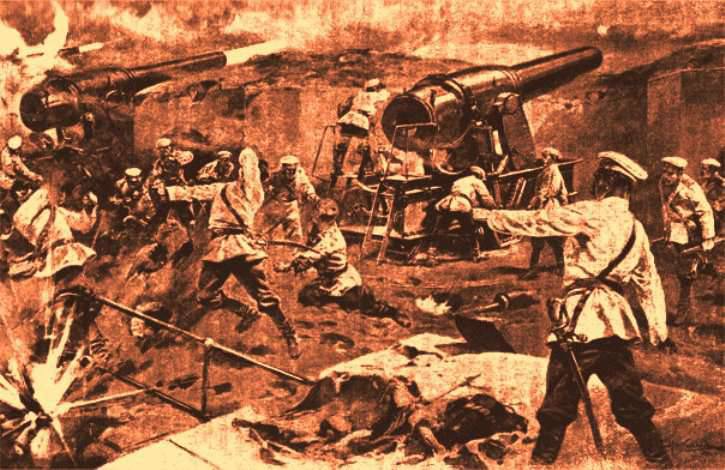
The name of the remarkable Russian artilleryman Leonid Nikolayevich Gobyato gained fame in connection with the invention of a new type in the besieged Port Arthur weapons - mortar. Usually, this invention confines the achievements of Gobyato in the minds of the broad masses. In fact, Leonid Nikolayevich’s contribution to the development of Russian artillery and military art is much greater.
In the difficult days of the siege of Port Arthur, military merit and deep special knowledge advanced Gobyato, then a captain, to the post of assistant commander of the Kwantung fortress artillery to observe the shooting technique. According to the artillery part, he was charged with “establishing everything that may be required according to circumstances and conditions”. It was at that time L.N. Gobyato created a mortar. He designed several samples of the original pole-mounted over-caliber winged mines and adapted for their throwing 47-mm naval guns. Thus, it turned out an apparatus capable of shooting mines at large elevation angles at close distances.
9 November 1904 was the first mine to appear over the Japanese trenches, and on that day 6 fired shots from a new weapon. When flying, the mine looked like a spear; the wings eliminated the oscillation of the pole, which made it possible to ensure an even trajectory. Side wind almost did not dismiss such a projectile to the side.
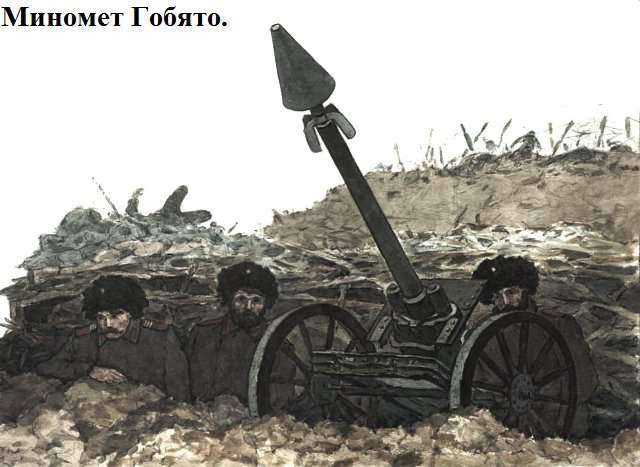
After returning from Japanese captivity, Leonid Nikolayevich published an article “Artillery firing at a fortress at a distance closer than 1000 steps”, where he highlighted the experience of artillery firing at Port Arthur at close distances. The article was first formulated tactical and technical data of new weapons. The inventor believed that the apparatus for conducting artillery fire at close distances should satisfy the following conditions: have sufficient accuracy; be lightweight for easy carrying; shoot at elevation angles from 45 ° and more; throw at least 15 pounds of high explosive explosives; the greatest distance when firing from the apparatus should be determined by their accuracy, which should be the highest at distances from 500 to 100 steps or less.
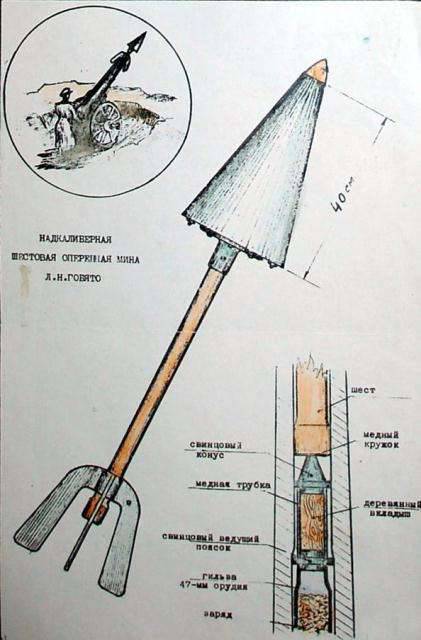
Gobyato stubbornly sought to ensure that the Russian army was equipped with mortars, but because of the inertia and inertia of the leadership of the military department, the issue was not resolved positively, and by the beginning of World War I, the Russian army was without this type of weapon. It began to produce during the war.
For many years L.N. Gobyato dedicated military-scientific activities, which differed practical orientation. Together with other leading officers, he revives the “Artillery Circle” created in 1902 at the Mikhailovsky Artillery Academy and speaks on his behalf with an appeal “To participants in the war with Japan”, urging him to collect materials from the past war, analyze them and immediately apply the findings to the case. Gobyato argued that the facts of the war, of which the officers were witnesses and participants, are “common property, obtained by the blood of tens of thousands of victims and costing terrible money”; Each officer is obliged to share his experience for general use. Leonid Nikolayevich believed that the more facts were collected, the greater would be the guarantee of avoiding mistakes in the new war.
The Artillery Circle rendered a great help in studying the experience of the Russian-Japanese war. Many officers engaged in military scientific work expressed their gratitude for the valuable information to the members of the circle and personally L.N. Gobyo. Appeal "To the participants of the war with Japan" Gobyato published as a preface to his work "Combat principles and norms of field artillery." In his opinion, the entire sum of the facts collected by the participants in the war would allow them to derive norms, and then the principles of Russian artillery, which fully agree with the spirit and properties of the army. "These principles will be understood by everyone, and then the chiefs will trust their subordinates, and that initiative of subordinates will be shown, which will give unity to the conduct of the battle."
Considering the issue of command and control of troops in battle, Gobyato argued that the principle of combat is the unity of actions of all its participants. This principle is unchanged. Gobyato emphasized that the idea of a battle must be known to all. He cited the example of Suvorov, who said: "Every soldier must know his own maneuver." Also, according to Leonid Nikolaevich, it was worthwhile to adopt the Suvorov principle of teaching troops short and clear principles of military affairs - “the troops understood him well, and therefore he always won.
One of the main issues raised in the work was the question of artillery firing from closed positions. Gobato not by chance paid him special attention. Among the combined-arms and artillery commanders, even after the Russian-Japanese war, there were many opponents of such use of artillery. In his work, the author also dwelt on such an important issue as the massing of fire and artillery.
But these ideas of Gobiato did not find due development in the Russian artillery of the pre-revolutionary period. Considering the issue of massing fire and artillery, and noting the priority of L.N. Gobyato in its development, the Soviet researchers V.M. Ivanov and M.N. Katkhanov emphasized that his comprehensive theoretical and practical solution was achieved only in Soviet times.
In the appeal “To the participants of the war with Japan,” the author sharply spoke out against admiring foreign authorities, seeing this as one of the reasons for the Russian lagging behind in artillery tactics. “We,” he wrote, “got used to looking at ourselves from the point of view of foreign authorities, we studied even our 77 — 78 campaign according to German sources, fearing to touch the living participants of the war.” The author of the appeal believed that tactical issues should be developed on the basis of his own experience.
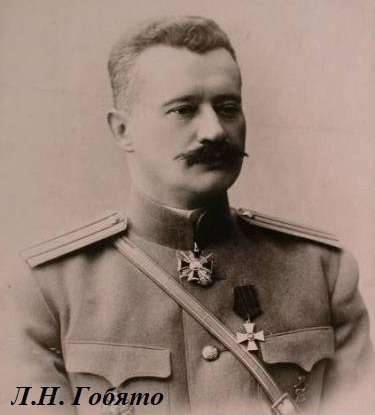
Gobiato's speech against foreign authorities caused a storm of indignation from their fans. On the pages of the military newspaper "Russian Invalid", there was a sharp controversy with representatives of the conservative direction, who did not conceal their commitment to foreign authorities and were ardent opponents of introducing artillery into tactics of firing from closed firing positions. After giving a worthy rebuke to his opponents, Gobiato concluded that all the evil of the Russian artillery is that the army leadership does not go forward, but lives solely by Napoleon’s tactical methods. The message Gobiato was soon published in the journal “Society of adherents of military knowledge,” and when, under pressure from the broad masses of the Russian public, the trial of the perpetrators of Port Arthur began, the editorial board released it in a separate book in mass circulation. In this process, the message Gobyato was used as an accusatory material.
The appeal "To the participants of the war with Japan" and the theoretical work "Combat Principles and Field Artillery Norms" brought their author fame in military circles as well as among the general Russian public. He was attracted, in particular, to cooperate with the publishing house "Military Encyclopedia".
Like other advanced Russian officers, Gobiato persistently sought the creation of a special commission to study the experience of the Russian-Japanese war. In 1907, such a commission began work. For three years she prepared a nine-volume work, containing a description of the war according to official documents.
The author himself made a valuable contribution to the study of the experience of the past war. 23 February 1907 of the year he spoke in the "Society of adversaries of military knowledge" with a message about the battle of Jinzhou 13 May 1904. Based on concrete facts, Gobyato revealed the criminal attitude of Stoessel, Fock, other generals and the tsar's governor in the Far East, Admiral Alekseyev, to strengthening and defending the Jinzhou position. It was the fault of the mediocre command that the Russian troops, despite the heroism shown, were forced to abandon this position, which allowed the Japanese to freely seize the cities of Dalniy and Tolienvan and block the port-arthur garrison from land.
In Gobyato's “Fight at Jinzhou” work, serious tactical questions were considered: on the use of complex fortifications in the defense of trenches; the occurrence of rare chains with dashes, crawling and samokapyvanie; massaging artillery fire in battle and the order of artillery in defense; closer interaction between different branches of service; use of technical means of communication; roles in modern combat machine guns and their application. Gobyato, for example, insistently demanded to abandon the existing vicious practice of group use of machine guns; on the widespread use of fire from closed positions; other issues that were relevant to the military art of the time were also considered here. The past two world wars later fully confirmed the correctness of the conclusions made by Leonid Nikolayevich.
In July 1908, after completing the course of the Officer Artillery School, L.N. Gobyato joined the school as one of its leaders. In the same year he was invited to teach artillery tactics to the Russian Academy of the General Staff. The experience of war, school and academy classes, trips to Italy, France and Germany to get acquainted with artillery units, participation in commissions for the preparation of textbooks and manuals, gave rich material for his scientific work.
In 1908, L.N. Gobyato published the book “The Property of Fire and the Military Service of the Artillery Division”, which was adopted as an official manual for the troops and was a continuation of his previous work “The Combat Principles and Norms of Field Artillery”. The work was written with the aim of resolving one very important issue for the Russian gunners. For more than 12 years in the Russian artillery there existed the post of division commander, but, despite such a long period, no one really knew what he should do. The duties of the division commander were not established, and it was Gobyato who defined them.
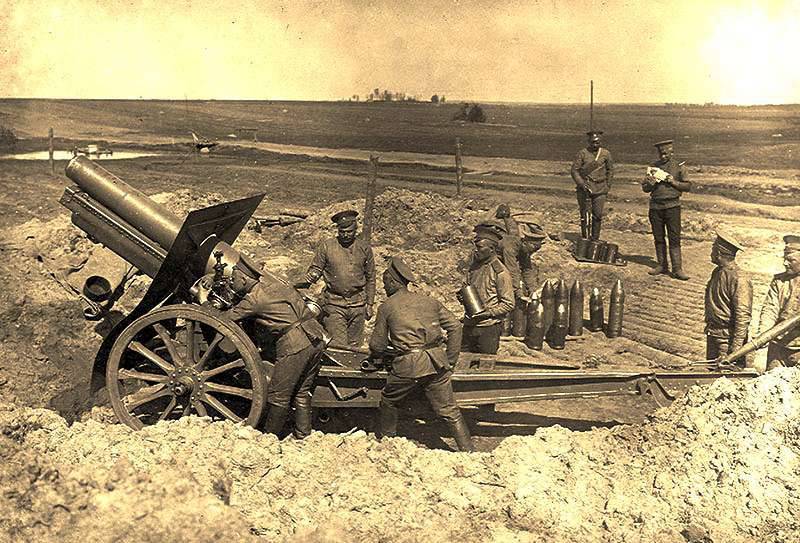
Also, the book covered a whole range of questions of artillery tactics (comparison of the properties and fire of guns and howitzers, preparation of attacks, choice of positions, organization of intelligence and communications, control of artillery in battle, etc.), as well as some issues of a general arms nature.
Gobiato’s thoughts on the organization of the army deserve attention. “To extract from the army,” he wrote, “all its power, you need to have it flexible.” Leonid Nikolayevich believed that the flexibility of the army depends on its proper organization and training. Each theater of war requires its own organization, and even at the same theater, depending on the local conditions and task of the detachment, the ratio of arms in the detachments should vary greatly.
No less interesting and Gobyato statements about some ways of conducting military actions. According to him, "modern mass armies" will be based on fortified positions, the fight against which is possible only with the joint action of siege and field artillery. " These views were undoubtedly advanced for that time and also testified to the vision of L.N. Gobyo.
Leonid Nikolayevich's military-scientific activity continued in subsequent years. He developed instructions and manuals ("Foundations of artillery reconnaissance and organization of the work of intelligence officers", "Corner plans on paper", "Celluloid Sector", "Instruction for summer topographical studies of officers of the Military Engineering Academy"), participated in the drafting of the Heavy Artillery Charter of 1910 g ., prepared for students of the Academy of the General Staff a synopsis of his lecture series “Artillery of field armies”.
Two years before the First World War, in the spring of 1911, the Main Artillery Directorate issued a “Field Artillery Shooting Guide”. The sections "Fire Control", "Organization of Intelligence" and "Positions" were developed by L.N. Gobyo. This manual played a very positive role in the preparation of Russian artillery on the eve of the First World War. Last, during the life of L.N. Gobjato, published his work "Synopsis for the practical acquaintance with the material part of the 1913 field artillery."
All the works of L.N. Gobyato are filled with the desire to improve the techniques and tactics of the Russian artillery. The author is characterized by a deep analysis of the subject matter of the research, a skillful selection and posing of individual questions in his field, a specific approach to their solution. While approving certain principles and norms, he at the same time pointed out the need for their flexible application, strict coordination of actions with the situation. His works are a vivid testimony of the achievements of advanced Russian military-theoretical thought of the beginning of the 20th century, which did not lose their significance in the subsequent period, including during the years of the Patriotic War and even in subsequent conflicts.
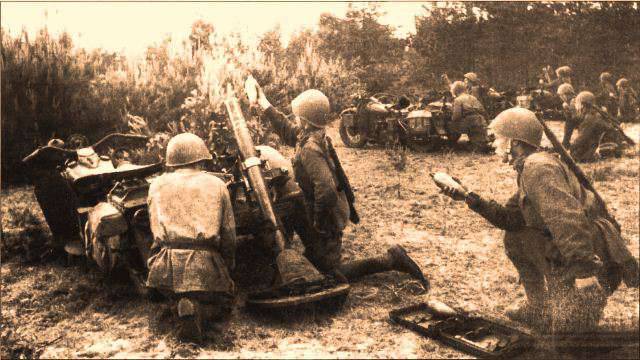
Patriot, a talented researcher and inventor, L.N. Gobyato was at the same time a gifted military leader who showed exceptional commanding qualities, courage and bravery inherent in the best representatives of the Russian officer corps in the fire of fighting. Unfortunately, Leonid Nikolayevich died early. During the First World War during the siege of Przemysl L.N. Gobyato was appointed commander of the 35 artillery brigade. 19 May 1915, he personally led the infantry to the counterattack and was mortally wounded during the battle. He was at that time all 39 years. Already after Gobiato’s death, the rank of lieutenant general was conferred, and a stela depicting a mine was installed on his grave.
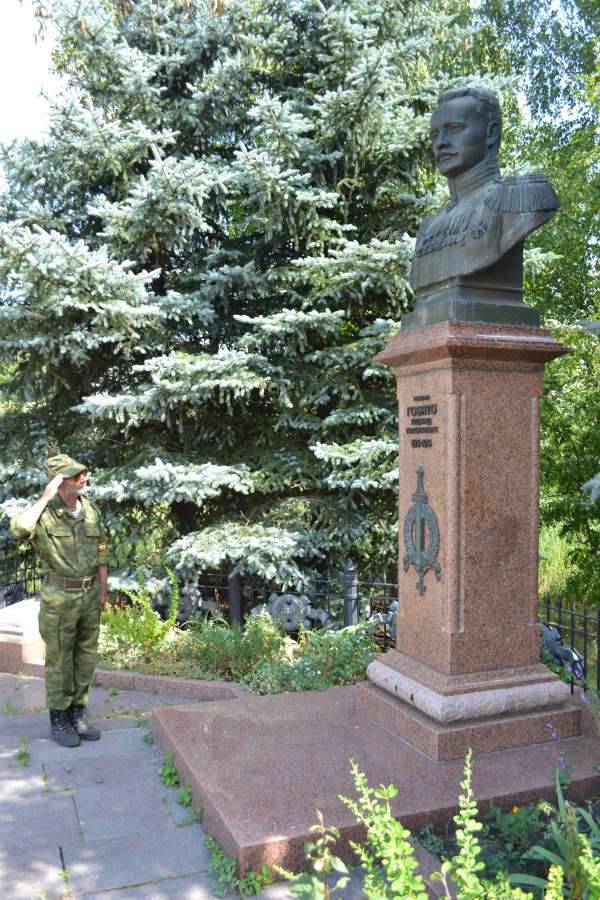
Sources:
Latukhin A. Mortars firing. M.: DOSAAF, 1980. C. 5-7.
Baths M. Captain Gobyato's Legacy. // Computerra. No.13 (777). C.11-13.
Sizova I. General artillery Gobyato. // Ryazan Gazette. 195 (4743) from 17 October 2014
Starov N. Russian gunner L.N. Gobyato. // Militaryhistorical magazine. 1972. No. 5. P. 28-30
Nepomniachtchy N. 100 great mysteries of the XX century. - M .: Veche, 2004. C. 276-279.
Information